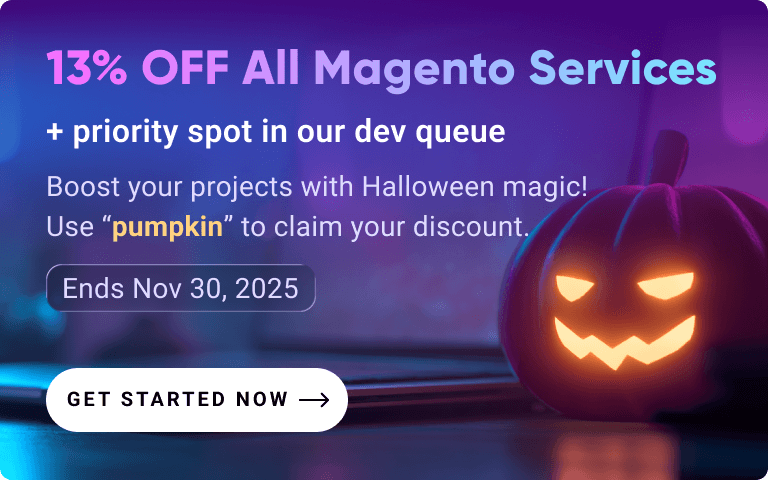Magento powers over 250,000 live websites globally, which confirms its dominant force among e-commerce platforms. This means business owners and developers need a clear view of the platform's evolution to guide their strategic choices. With the rise of competitors like Shopify Plus and BigCommerce, and major shifts like the Adobe Commerce transition, the wrong decision can lead to significant technical debt or missed opportunities.
This article analyzes the latest statistics and trends, drawing from authoritative sources like Envisage Digital, MageComp, and StoreLeads, to clarify Magento's current standing and future prospects.
Magento Market Share
To grasp Magento's market position, you must look beyond its share of the entire web. Its real strength lies in its position within the e-сommerce platform market itself.
Globally, Magento holds a spot among the top five e-commerce platforms, with a market share of about 8%. This figure becomes more impressive when we analyze the type of sites it powers. Magento disproportionately dominates the enterprise and mid-market segments. It is a leading choice for sites in the top 10,000 and top 100,000 by web traffic, which proves its scalability for high-growth businesses.
Magento maintains its relevance because it offers unmatched customization and control, which cements its role as a powerhouse for complex, large-scale online stores. While it may not have the sheer volume of small-store installations, its market share is defined by quality and revenue scale, not just quantity.
Top Countries Using Magento E-commerce Platform
Magento is most popular in countries with strong economies and advanced digital infrastructure, but it's also growing in emerging markets. This geographic pattern shows where the platform provides the greatest value.
Top Regions
Magento is most popular in North America and Europe. These regions have mature e-сommerce markets and many skilled developers. Many medium and large businesses there need Magento's powerful features. North America has the most stores, while European companies value its ability to run shops in different countries.
Top Countries
The United States has the most Magento stores by a large margin. Other leading countries are the United Kingdom, Germany, and the Netherlands. Australia also has strong adoption. All these nations have the advanced technology and resources needed to support the platform.
Emerging Markets
Magento is growing in key emerging markets like Brazil and India. Businesses in these regions often choose Magento when they plan to expand internationally or have complex needs. While finding expert developers can be harder, the platform's scalability makes it a good choice for ambitious, growing companies.
This table summarizes Magento's key geographic markets and their primary characteristics:
| Region | Status | Key Countries | Primary Driver |
| North America | Established Leader | United States | High density of enterprises & developers |
| Europe | Mature Market | UK, Netherlands, Germany | Demand for multi-currency/multi-language |
| Asia-Pacific | Growth Market | Australia, India | Expansion of mid-market e-commerce |
| Latin America | Emerging Market | Brazil | Scalability for growing enterprises |
Big Brands that Use Magento
Magento is the platform of choice for many leading global brands that require a powerful, customizable, and scalable e-сommerce solution. Its ability to handle complex product catalogs, high traffic volumes, and sophisticated customer experiences makes it ideal for large enterprises.
The table below shows the primary sectors where major brands rely on Magento, followed by some of the most successful examples.
| Area / Industry | % Share of Major Brands | Notable Examples |
| Home & Garden | ~22% | Cox & Cox, Temple & Webster, Utility Design |
| Food & Beverage | ~18% | Coca-Cola (regional sites), Nestlé, Heinz |
| Fashion & Apparel | ~15% | Surfstitch, END. Clothing, Paul Smith |
| Electronics & Technology | ~12% | HP Home, Nothing.tech, Mous, Wex Photo Video |
| Health & Beauty | ~10% | Lookfantastic, Cosme-de.com, Feelunique |
| Sports & Recreation | ~8% | Tennis-point, Surf hardware, Skatewarehouse |
These companies leverage Magento to drive billions in online sales.
Coca-Cola (Beverage) – Utilizes Magento for its branded merchandise stores, offering a seamless shopping experience.
Ford (Automotive) – Employs Magento to manage its extensive catalog of vehicle accessories and parts.
Nestlé (Consumer Goods) – Uses Magento to showcase and sell a diverse range of products efficiently.
Olympus (Electronics) – Leverages Magento’s capabilities to handle detailed product information and customer inquiries.
Warby Parker (Retail) – Opts for Magento to facilitate a user-friendly eyewear shopping experience online.
Nike (Sportswear) – Implements Magento for its robust inventory management and customizable design capabilities.
HP (Technology) – Utilizes Magento to maintain a feature-rich online store for tech products and accessories.
Canon (Photography) – Chooses Magento for an intuitive browsing and purchasing interface for cameras and equipment.
Jaguar (Luxury Automotive) – Uses Magento to deliver high-end automotive accessories and branded merchandise online.
Adidas (Apparel) – Employs Magento for an engaging and scalable online presence, supporting large product inventories.
Magento to Shopify Migration Trends
While no official statistics track exact migration numbers between e-commerce platforms, consistent industry analysis and market share data reveal a clear trend: a significant number of businesses (small to medium-sized ones) have moved from Magento to Shopify in recent years. This shift is primarily driven by the appeal of Shopify's streamlined, all-in-one solution compared to Magento's more complex, self-hosted environment.
Why Businesses Are Making the Switch
| Primary Reason | Typical Business Profile |
| Lower Total Cost of Ownership | SMBs seeking to reduce development and maintenance costs |
| Simplified Maintenance & Updates | Businesses without dedicated in-house technical teams |
| Faster Time-to-Market | Companies needing to launch or pivot quickly |
| All-in-One, Managed Solution | Brands wanting to focus on sales rather than tech management |
Notable Companies That Have Switched
Several well-known brands have publicly migrated from Magento to Shopify:
Gymshark – Moved in 2020 to handle rapid growth and simplify operations
Heinz – Selected Shopify Plus for global brand consistency
Staples Canada – Migrated to improve customer experience and reduce complexity
Brooklinen – Switched to scale more efficiently during expansion
KITH – Moved to Shopify for better performance and mobile experience
What This Means for Magento
Despite these migrations, Magento maintains strength in several key areas:
- Enterprise segment remains largely loyal (businesses with $50M+ revenue)
- B2B and complex catalog businesses typically stay with Magento
- Customization-heavy operations continue to prefer Magento's flexibility
The migration trend primarily affects small to medium businesses that find Shopify's simplified model better matches their current needs and resources. Both platforms continue to evolve, with Magento focusing on enterprise features while Shopify improves its scalability for larger merchants.
Migrating to Magento: Why Businesses Upgrade Their Platform
While precise migration figures are not officially tracked, industry analysis indicates Magento attracts thousands of businesses annually from other platforms. These migrations typically occur when companies outgrow their initial e-commerce solution and require Magento's advanced capabilities for scalability and complex operations.
Where Businesses Are Migrating From
Businesses moving to Magento often come from platforms that can no longer support their growing needs:
Shopify – Businesses requiring advanced B2B features beyond basic retail
WooCommerce – WordPress sites needing dedicated e-commerce infrastructure
BigCommerce – Companies seeking deeper customization options
Custom Solutions – Organizations replacing outdated legacy systems
Why Businesses Migrate to Magento
The decision to migrate to Magento typically aligns with specific business expansion needs:
| Primary Driver | Business Profile |
| Advanced B2B Features | Wholesalers, manufacturers, distributors |
| Complex Catalog Management | Businesses with extensive inventories (10,000+ SKUs) |
| Multi-store Operations | Brands expanding into new regions and currencies |
| Custom Workflow Needs | Companies requiring tailored operational processes |
| International Expansion | Companies scaling globally |
Successful Migrations to Magento
Several major brands have moved to Magento to power their growth:
Coca-Cola – Migrated regional merchandise stores to Magento for global consistency
Warner Music Group – Moved from multiple platforms to unified Magento solution
Fanta – Selected Magento for global brand store operations
Foster's – Migrated to Magento for enhanced e-commerce capabilities
Rebecca Minkoff – Moved to Magento for improved omnichannel experience
Top Magento Extension Statistics
Magento's extensible platform allows businesses to customize and enhance their online stores with a variety of plugins. These extensions add functionalities that cater to specific needs without the requirement for extensive coding. Here’s a look at the aspects where Magento plugins are most commonly utilized:
- SEO and Marketing – Many businesses use plugins to optimize their store for search engines and manage marketing campaigns more effectively.
- User Experience – Enhancements like advanced layered navigation and customized checkout processes improve overall customer experience.
- Inventory and Order Management – Plugins simplify the management of stock across multiple locations and order processing.
- Analytics and Reporting – Businesses rely on plugins for insightful analytics, helping them make data-driven decisions.
- Security – Security-focused extensions offer enhanced protection against online threats.
Most Popular Amasty Plugins for Magento
Amasty, a well-known Magento extension developer, offers a range of popular plugins that many businesses rely on:
SEO Toolkit – Enhances search engine visibility with comprehensive SEO features.
Improved Layered Navigation – Provides an intuitive and customizable navigation experience for users, making it easier to find products.
Multi-Warehouse Inventory – Efficiently manages stock across multiple warehouses, improving order fulfillment and inventory tracking.
Advanced Reports – Delivers detailed analytics and reports, enabling businesses to make informed operational decisions.
Abandoned Cart Email – Boosts sales by automatically sending targeted emails to recover abandoned shopping carts.
Other Magento Facts & Figures
Magento is not just about flexibility and scalability; it's an ecosystem that offers a variety of fascinating insights:
- Community and Developers – Magento boasts a thriving community with over 300,000 developers. This robust support network contributes to continuous innovation and improvement.
- Extensions Marketplace – The Magento Marketplace has over 5,000 extensions available, offering solutions for everything from payment integration to customer service enhancements.
- Global Usage – Magento powers over 250,000 websites worldwide, with a significant concentration in the United States and Western Europe.
- Version Adoption – The transition from Magento 1 to Magento 2 has been significant, with over 70% of active Magento sites now running on Magento 2, benefiting from improved performance and security features.
- Page Load Speeds – Magento 2.4 offers enhanced page loading speeds, approximately 20% faster than previous versions, contributing to better user experiences.
- Security Patches – Magento regularly releases security patches, emphasizing its commitment to providing a secure e-commerce environment. This is crucial in maintaining trust with merchants and customers alike.
- Partner Ecosystem – Magento has a strong network of partners, including over 300 technology and solution integrators, ensuring businesses get the support and services they need.
Frequently Asked Questions
Yes, Magento continues to innovate with new features and improvements, making it a relevant and competitive option in the e-commerce space. Its strong community and flexible platform ensure its future growth.
Absolutely. Magento remains a popular choice for businesses of all sizes looking for a customizable and robust e-commerce solution.
No, Magento is actively developed and supported. While Magento 1 has reached its end of life, Magento 2 is thriving with regular updates and enhancements.
Over 250,000 active websites currently use Magento, illustrating its widespread adoption and appeal across various industries.
Shopify holds the largest market share in e-commerce, but Magento continues to be a leading platform, especially for businesses needing extensive customization and scalability.









